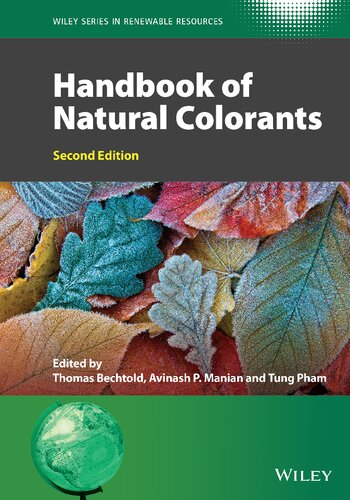

Most ebook files are in PDF format, so you can easily read them using various software such as Foxit Reader or directly on the Google Chrome browser.
Some ebook files are released by publishers in other formats such as .awz, .mobi, .epub, .fb2, etc. You may need to install specific software to read these formats on mobile/PC, such as Calibre.
Please read the tutorial at this link: https://ebookbell.com/faq
We offer FREE conversion to the popular formats you request; however, this may take some time. Therefore, right after payment, please email us, and we will try to provide the service as quickly as possible.
For some exceptional file formats or broken links (if any), please refrain from opening any disputes. Instead, email us first, and we will try to assist within a maximum of 6 hours.
EbookBell Team

4.4
52 reviewsHandbook of Natural Colorants
Second Edition
A detailed survey of a variety of natural colorants and their different applications including textiles, polymers, and cosmetics
Colorants describe a wide range of materials such as dyes, pigments, inks, paint, or chemicals, which are used in small quantities but play an important role in many products such as textiles, polymers, food, and cosmetics. As the effects of climate change begin to be felt, there has been a shift in focus in the field to renewable resources and sustainability, and an interest in the replacement of oil-based products with greener substitutions. As the push to adopt natural resources grows, there have been significant developments in the research and application of natural colorants as a step in the transition to a bio-based economy.
The second edition of Handbook of Natural Colorants provides a detailed introduction to natural colorants in a marriage of theory and practice, from seed of plant to consumer demand. Presenting a wide range of viewpoints, the book briefly discusses the history of coloration technology and the current position of natural colorants before highlighting detailed information on regional plant source availability, colorant production and properties, as well as analytical methods for isolation, identification, and toxicity aspects. It also presents key applications in technical use and consumer products, including the use of natural colorants in textiles, hair dyeing, printing, and packaging. Finally, the text considers environmental and economic aspects of natural colorants.
Handbook of Natural Colorants is a useful reference for dyers, textile producers, and researchers in the evolving field of sustainable chemistry, environmental sciences, agricultural sciences, and polymer sciences.
For more information on the Wiley Series in Renewable Resources, visit www.wiley.com/go/rrs